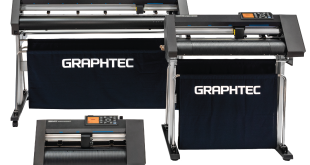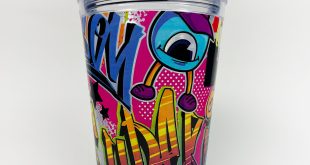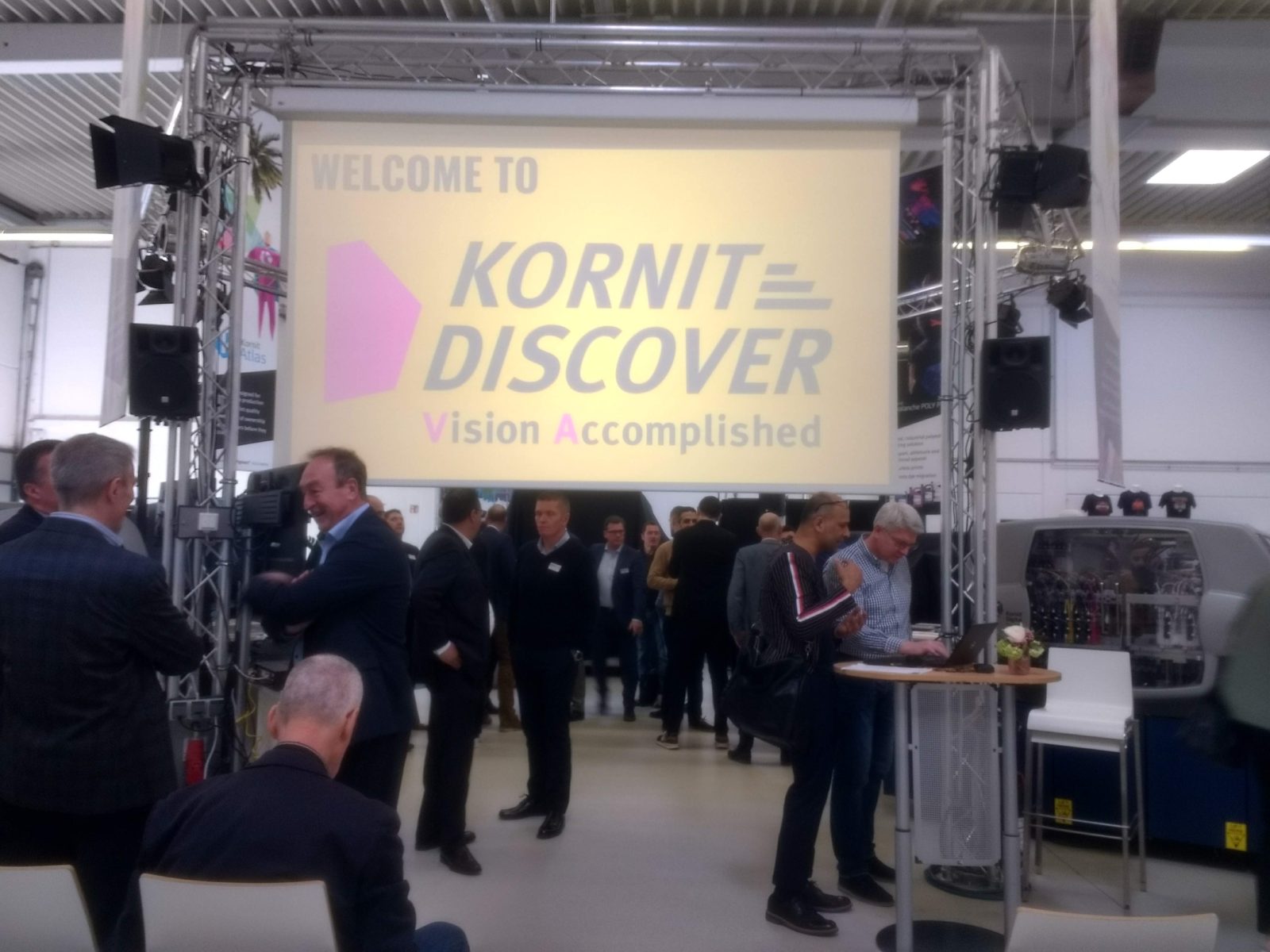 On Thursday, April 11 and Friday, April 12, Kornit hosted a thought-provoking open house event entitled Kornit Discover. P&P editor Melanie Attlesey attended to seek insight into the future of direct to garment printing.
On Thursday, April 11 and Friday, April 12, Kornit hosted a thought-provoking open house event entitled Kornit Discover. P&P editor Melanie Attlesey attended to seek insight into the future of direct to garment printing.
I arrived in Düsseldorf not knowing quite what to expect from the open house. The event was described as the chance to discover the future of digital textile printing through a series of talks and product launches and in my opinion it certainly lived up to the prelude.
Providing the friendly welcome to the hundreds of visitors that took the time out of their busy working day to attend the open house was marketing director Oliver Luedtke. He hoped that all attendees left inspired with ideas for the future after listening to the speakers that were lined up to talk throughout the day.

Now is the time
First up to talk was Kornit’s new CEO Ronen Samuel, who has been in the role since August 1, 2018. His talk was called ‘The time is now’, where he discussed how textile printing is changing and how Kornit is going to be at the forefront of the digital textile printing revolution.
“We believe the time is now to turn textile printing digital. Kornit is going to play a huge part in this. We will lead the way in this transformation,” he said.
Ronen suggested that there is currently a perfect storm happening in the world right now and went on to describe four mega trends that are here to stay for the long-term, that will have a major influence on all of us, in particular the digital textile printing market.
The first mega trend is personal experience. The young generation like to be unique and show their own identity. They enjoy the self-expression experience. In recent years, brands such as Coca-Cola have understood this and have catered for this trend. This mega trend is here to stay and will only increase in importance.
The second is social media; it’s all around us and cannot be avoided. Ronen estimated that around 86% of women in the world use social media at some point to look for fashion trends. Brands understand the influence that social media has and use celebrities such as the Kardashian family and Cristiano Ronaldo to sell their products. It’s this source of instant gratification which is fuelling the rise in short runs and on-demand printing. If the consumer cannot get their order instantly they will go elsewhere, suggested Ronen.
The third trend is a boom in e-commerce and as Ronen said, the textile industry is the fastest growing part of this sector. Shopping online is convenient and can be done anywhere. Shoppers can compare prices and take advantage of virtual and augmented reality during their experience, and then receive their product within 24 hours. As a result of the boom in e-commerce brands have to change the way they operate and reinvent themselves.
Ronen used Nike as an example in this situation. Customers can personalise their shoes or T shirts in store or order online and collect in store. This keeps the need for the retail store.
E-commerce is also shortening the fashion cycle. Take high street retailer, Zara, for example. It used to take many months for new styles to reach the shop floor, but because of the need for instant fashion, it now takes only three weeks for new styles to go from design to shop floor. This means that Zara no longer manufactures in China and has instead brought the factories closer to where the retail stores are situated.
“If you are not unique or offer personalisation which is in touch with the customer, then you will soon get left behind,” Ronen said.
The fourth mega trend is sustainability, which the younger generation is very keen on. Digital textile printers should consider this aspect when assessing their business plans.
To conclude his talk, Ronen went on to discuss the future of digital textile printing. He explained that at present there are 15 billion decorated garments produced globally on an annual basis, which is expected to grow to 25 billion by 2023. Of this, only 5% are printed digitally, providing huge scope for growth.
To prepare for this uptake in digital textile printing, Kornit launched two products during the open house; the Presto and Poly Pro. The Presto is described as being an advanced single-step solution for direct to fabric printing. While the Poly Pro has cracked the enigma that was printing digitally onto 100% polyester fabric. At this point in the day neither machine had been unveiled and Ronen told the audience to prepare to be blown away.
“Kornit is obsessed with customer success. By being successful together we can change the industry. There is a little saying that the best time to plant a tree was 20 years ago and the second best time is now. The same can be said for digital printing, the best time to go digital was five years ago, the second best time is now,” and that’s how Ronen ended his presentation with that interesting proposition.
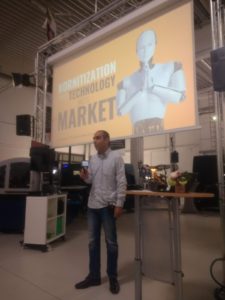
New technology
Next up was Kobi Mann, Kornit’s vice president of Consumables & Application Development. His topic of choice was ‘The Revolutionary NeoPoly Technology’, which as the name suggested focused on Kornit’s unique printing process.
Kobi began his talk by providing a brief overview of how Kornit’s products have evolved since the introduction of the Storm in 2004. This printer’s capabilities were limited to printing only 15 T shirts an hour.
“As time progressed we have created a process that reduces the cost per print and a reduction in waste,” explained Kobi.
Now in 2019, Kornit looks to shake up the digital printing market with the Atlas (a next-generation, super-industrial DTG printer utilising NeoPigment technology) which was launched in January and the aforementioned Poly Pro. Both printers signify a breakthrough in technology.
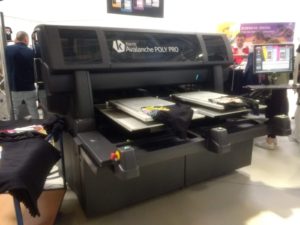
Polyester sportswear is the one of the fastest growing apparel markets in the world, and Kobi explains that as a technology provider, Kornit needs to respond to this, hence the development of the Poly Pro, which prints on 100% polyester with ease. “People are wearing much more synthetic material, today. Cotton is no longer sustainable,” explained Kobi.
The Poly Pro overcomes one of the biggest problems of printing polyester – dye migration – with its enhanced curing mechanism and NeoPoly technology. No blocker or additional steps are required. The printer communicates with the textiles that are being printed.
Kobi concluded that the Poly Pro is sure to change the landscape of digital textile printing, by opening up new possibilities, which was clear to see upon its unveiling later in the day.
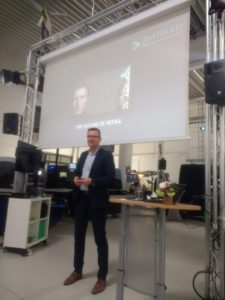
The future of retail
I must admit I was truly fascinated by what the third speaker had to say. Dr Jörg Wallner, a futurist at think tank 2b AHEAD, took centre stage to talk about the future of retail. And what he talked about really was futuristic and hard to comprehend at this moment in time.
He ran through how technology is changing in home, with virtual wardrobes that will select and order clothes at the touch of a button, to toilets that will be able to analyse your health. He said the future is mobile and businesses need to adapt.
Jörg explained that we are living in a mobile world, one where users no longer have the distinction between their online and offline worlds. He predicted that by 2022 there will be one trillion connected devices worldwide.
Jörg gave examples of two retailers that were using technology and connected devices to change the way that consumers shop. One Chinese retailer, called Suning has opened five retail stores in the country that are completely automated and unmanned. The stores are powered by facial recognition technology and a smartphone app. Shoppers can link their bank account to the app and get billed for anything they purchase by simply walking out of the store with the items. Also in China, KFC allows diners to pay for their food by smiling.
The futurist ended his fascinating insight into the future of retail by stating that we are currently at a tipping point in society and businesses should start now to reinvent themselves in a world where technology is ever present. He said it’s better to make this happen now, rather than stand by and then afterwards ask what happened. Just do something was his final thought.

Digital transformation
On stage first after lunch was Tansy Fall, head of content at World Textile Information Network, with her topic ‘Digital transformation of the textile and apparel value chain’. She began by saying that digital transformation moves business into a new era.
She said there has to be a reason for change and cited Burberry as an example. In 2017, the brand burnt £28m worth of stock in order to protect its brand and as a result has now changed its practices due to this unsustainable business model. Tansy stressed that it’s important the supply chain changes its practices to become more sustainable and that in doing so should consider people, planet and profit along the way.
The way Tansy sees the digital transformation of the supply chain is through data harnessing. That being the sharing of data all the way along the supply chain. This will enable the industry to produce only the textiles that are needed. The power of one and on-demand manufacturing is the fourth stage in the industrial revolution, which is where the strengths in digital textile printing lie.

Customer insight
Next up was a fireside chat with Kornit customer Kevin Marschall of Shirtracer. Oliver Luedtke conducted the interview in front of an audience who were keen to hear the secrets of a business that prints 4,800 shirts a day.
Kevin explained that the business was founded in 2008 in the living room of CEO Denny Kühne. Denny was a chimney sweep by trade, but wondered why there were so many T shirt printers doing large print runs, instead of one off designs. This is how he started the business, initially printing T shirts with flex film. Shirtracer went digital in 2013 with the introduction of a Brother GT3. By 2017 they had five of these printers and had grown to the point where they had to make the decision whether to buy five more or to buy an industrial machine. Shirtracer took the decision to purchase an Avalanche Hexa and now two years later the business has four of them, capable of printing 4,800 T shirts a day.
Kevin says that the introduction of these printers has saved the business money in the long run, as cost per print is lower and less staff are needed to operate the printers. “The initial investment is a little higher, but you have to look at the total cost of ownership,” he said.
After reaching a level of production that works, Kevin said the focus now for the business is making it more sustainable. From my point of view it was great to receive an insight into the business of a garment decorator of this size.

Fashion design
Last up on the stage was Davinder Madaher, a textile designer with 27 years’ experience. His presence at the open house was to inspire printers to get creative and to encourage them seek out the help of designers to help elevate their business to the next level.
He explained that the rise of digital printers has helped fashion designers like himself to bring their designs from concept to finished product quicker than ever before. He advised printers to invest in their design team. “You want to sell the best designs you can to your customers,” he said.
Davinder outlined the advantages of digital printing over screen printing, including high resolution, unlimited colours, no screens to cut, quick turnaround, among many others, before finishing his presentation by exclaiming just how excited he was about the future of digital printing from a designers point of view, hoping that he had inspired everyone to get creative.
The future of Kornit
All in all, the day was very informative and it is exciting to see the boundaries of digital textile printing being pushed. It is clear that Kornit solves existing problems and is truly focused on helping printers be successful in their field.
Kornit’s new CEO, Ronen Samuel, has been brought onboard to help drive Kornit towards its revenue goal of $500 million by 2023. This will be made possible through the introduction of new products and technologies, and by targeting new markets and customers. Only time will tell whether Kornit will reach its goal, but it has already hit the nail on the head with new innovative technology introduced this year alone, which will surely provide a catalyst for growth.
 Printwear & Promotion The Total Promotional Package
Printwear & Promotion The Total Promotional Package
